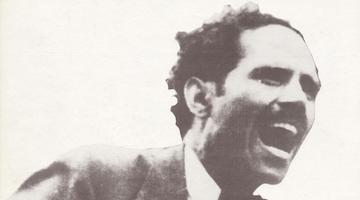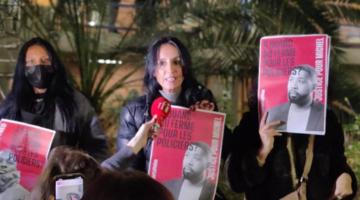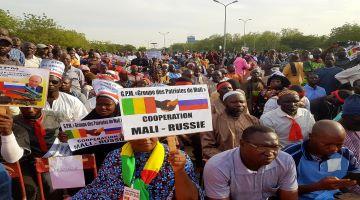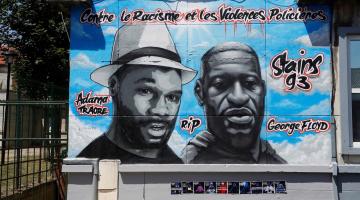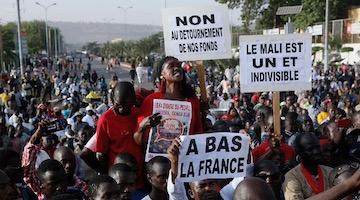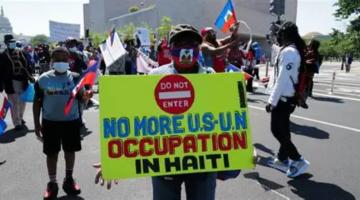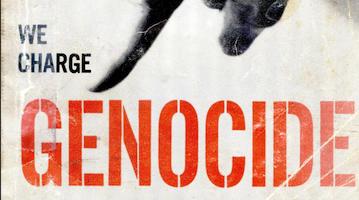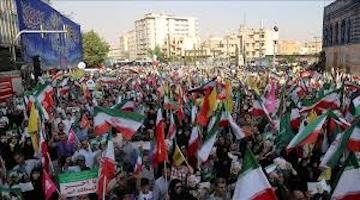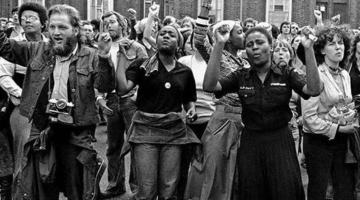To understand the current uprisings in New Caledonia, one must look back at the history of colonization and violent repression of the islands by France.
Originally published in Frustration.
Recently, a high-intensity revolt has been taking place in New Caledonia: looting, destruction of businesses, armed struggle against the police (molotov cocktails, live ammunition...), prison mutiny... In any other region of France, this would be front-page news. But New Caledonia isn't just any other region of France. It's a colony, and as such it's of little interest to mainland France, so it's hard to understand what's going on there. Let's try to unravel the mystery.
Back in time: the colonization of New Caledonia
New Caledonia is a group of islands in Oceania. Until the 18th century, the indigenous peoples of New Caledonia lived without Western interference. This situation changed in the late 18th and early 19th centuries. In the 1820s, British merchants began building “comptoirs” - foreign structures strategically placed to promote international trade. Twenty years later, missionaries arrived with the idea of changing the way of life of the people now known as Kanaks, transforming their beliefs and converting them to Christianity. Things didn't always go as well as planned, however, and in 1847 the Kanaks attacked one of the missions, beheading Brother Blaise Marmoiton. A foundation had been laid: the Kanaks might be colonized, but they would not let themselves be colonized.
New Caledonia: the former French gulag
Western ambitions for New Caledonia took on a new dimension in the following decade. Napoleon III (in power from 1848 to 1870) was looking for a territory to build new penal colonies. New Caledonia was officially colonized by France in September 1853. The French set up a “bagne,” a labor camp for prisoners working in appalling conditions. Prisoners were encouraged to stay on after serving their sentences, in order to promote colonization.
While common criminals were found there, New Caledonia was used on a massive scale to deport political opponents, turning it into a veritable “French gulag”. The Paris Commune revolutionaries who were not summarily executed were deported there in large numbers, as were Algerian resisters to the French colonization of 1830. Louise-Michel, who was deported there, spoke out on “the Kanak problem”. Convicts were used as virtually free labor to build colonial infrastructures. Capitalists became increasingly interested in the colony as nickel was discovered. Mining and metallurgy developed. The Kanaks would never passively accept French colonization.
In 1878, Aitaï, the Kanak “grand chief”, presented himself to the French governor, dumped a sack of earth and declared “this is what we had”. He then dumped a sack of stones and declared “this is what you left us”. Little by little, the French settlers monopolized the arable land, destabilizing the Melanesian food economy and leaving the natives with poorer quality land. Ataï, in collaboration with other tribal chiefs, began fomenting a plan to take Nouméa (now the capital of New Caledonia). But in June 1878, following the assassination of a settler family, things accelerated: the colonial administration locked up ten tribal chiefs. From June to August, the Kanaks changed their plans and launched large-scale attacks, killing around 200 gendarmes and colonists.
The insurrection was finally put down by France, and the repression was extremely bloody: Ataï was decapitated and his head, placed in formaldehyde, was sent as a trophy to Paris. Other Kanak chiefs were executed without trial and almost 5% of Melanesians were killed (around 2,000 people). The sadistic barbarity of French colonialism is etched in our memories.
During the First World War, Kanak soldiers found themselves fighting in a war that had nothing to do with them. On top of this, French colonialists grabbed even more land to meet the growing need for supplies. In 1917, a guerrilla war was organized around the figure of Noël, chief of the Tiamou tribe. This was put down after a year. Noël was also beheaded, and some sixty other rebels were condemned. After this new revolt, the French colonists tried a new approach. The aim was to train a “Kanak republican elite” who could corrupt the spirit of resistance from within.
In 1931, Kanaks were exhibited as if they were animals at the Colonial Exhibition in Paris. After the Second World War, New Caledonia's status changed. It was no longer officially considered a colony, and French nationality was granted to the Kanaks. The population gained the right to vote in 1957. New Caledonia became the world's 3rd largest producer of nickel, and the French authorities encouraged settlement. This influx of settlers increased the population by 20% in the first half of the 1970s.
At the same time, pro-independence ideas were developing, paving the way for a new era of anti-colonial revolt in the 1980s: what France came to call “les évènements”.
The “events”
In the 1960s, Kanak nationalist demands became more formalized. Left-wing students who had taken part in May 68 returned to New Caledonia. Far-left activist Nidoïsh Naisseline founded the “Foulards Rouges” (Red Scarves), while in 1971 other pro-independence activists formed the “Groupe 1878” (a reference to the uprising of that year). They demanded land restitution and wanted to preserve their identity. They merged to create the Kanak Liberation Party in 1975. Others followed, such as the Parti indépendantiste in 1979.
Pierre Declercq, a teacher and supporter of independence, was murdered in his home in September 1981. His killers were never found. Demonstrations broke out and roadblocks were set up. The situation continued to deteriorate in July 1983, when gendarmes were killed.
A referendum on self-determination was scheduled for 1989, but the pro-independence movement wanted the electorate to be limited so that it would be the indigenous peoples, not the colonists, who would vote. This demand was initially rejected. In 1984, Kanak independence activists traveled to Gaddafi's Libya for military training. The Independentist Front became the Front de libération nationale kanak et socialist (FLNKS – Kanak and Socialist National Liberation Front), and the latter called for a boycott of the 1984 territorial elections because of this electoral rule, which they considered illegitimate. One of the pro independence leaders, Eloi Machoro, broke a ballot box to symbolize the boycott. It was the start of a quasi-insurrection.
In November 1984, roadblocks were set up, the sub-prefect was sequestered, the police station was occupied in the commune of Thio, and five GIGN (elite police corps of rapid intervention) helicopters were disarmed. In December, European homes were looted and set on fire. The socialist French government sent in the army and gendarmerie, banned all demonstrations and placed the tribes under close surveillance.
After a brief period of calm, tensions flared again between the colonists and the independence fighters.
In January 1985, the GIGN executed Eloi Machoro, and a state of emergency and curfew were introduced.
To calm things down, Laurent Fabius's government granted New Caledonia greater autonomy and introduced a number of democratic reforms.
This did not last long, however, as the following year the Right returned to power with the cohabitation government led by Jacques Chirac. The “Pons I” statute was voted in, designed to counter pro-independence ambitions, reduce the powers granted to the “regional councils” and organize a referendum on self-determination.
Once again, the FLNKS explains that it will not take part in the referendum if the colonists can vote in the same way as the Kanaks. This is supported by the non-aligned movement, i.e. countries that refuse to be subservient to the United States or the Soviet Union. The UN General Assembly passes a resolution affirming “the inalienable right of the people of New Caledonia to self-determination and independence”, and places New Caledonia on the UN list of Non-Self-Governing Territories, i.e. non-decolonized territories “whose populations do not yet have full self-government”.
The referendum was boycotted by the independence movement, and in September 1987 this “self-determination” was unsurprisingly rejected. They also pledged to boycott the presidential and regional elections. In October, the perpetrators of an ambush in which ten independence leaders had been killed in 1984 were all acquitted by an all-European jury, triggering the anger of the Kanaks.
Two days before the 1988 presidential elections, FLNKS militants launched a new offensive: the Ouvéa hostage crisis. Around sixty independentists attacked a police station in Ouvéa and took twenty gendarmes hostage (four of them were killed during the attack). Half of the hostages were quickly freed, while the others were taken to a cave.
The French government declares the island a military zone and bans journalists. French soldiers have a field day: children are abused, and tied to hut posts in front of their families.
While the gendarmes are well treated by the kidnappers, Chirac talks to General Vidal and asks him what the Israelis and Thatcher would do in such a case. The general replied that they would launch an “intervention”, so Chirac decided to do just that.
On May 5, 1988, the assault was launched, and the Kanaks let the hostages escape without harming them. The official version was simple: 18 kidnappers were killed in action. Except that 12 of them were found with bullets in their heads in addition to their other wounds. In short, these were summary executions. In June, an amnesty law applied to all the facts of this affair, preventing an investigation of what really happened. Michel Rocard confirms: “At the end of the Ouvea cave episode, there were injured Kanaks, and two of these wounded were finished off with boots by French soldiers, including an officer (...) It was necessary to ensure that this would come to light, and it was therefore necessary to ensure that this too would be guaranteed by the amnesty”.
To restore calm, the Matignon Accords were signed, accepted in particular by the FLNKS. They were ratified by a referendum on self-determination in New Caledonia, which resulted in a Yes vote. It provided for a referendum on independence to be held ten years later.
The 2021 referendum contested
During this period, French governments encouraged the construction of factories and infrastructure. Inequalities on the archipelago remained quite significant. In 1998, the Nouméa Accords postponed by a further ten years the referendum on independence initially scheduled for that year.
The referendum took place in November 2018, with only Kanaks and “Caldoches” (descendants of long-settled colonists and convicts) voting. The “no” to independence won by 56.4%. By law, the Kanaks can hold two more referendums.
A new referendum on independence was scheduled for 2020. It was slightly postponed due to the Covid-19 pandemic. The pro-independence vote gained ground but lost again, with the “no” vote winning by 53.2%.
A third referendum was held in 2021, but this time it was boycotted by the independence movement. The French government refused to postpone the referendum, as requested s, because of the pandemic. As the independentists did not vote, the referendum unsurprisingly gave a very large victory to the refusal of independence (96%).
May 2024: revolt against constitutional reform
The French government tries to take advantage of the defeat of the independence movement to change the constitutional rules and limit the possibility of future independence. It wants to open up the right to vote to all residents of New Caledonia who have lived in the territory for at least ten years, which would gradually put the Kanaks in the minority.
In mainland France, deputies began considering this law on Monday, May 13. This sparked off a major revolt: vehicles were set on fire, stores looted, dozens of businesses and factories burned down, clashes with the police, barricades set up, and mutiny in prisons.
France Insoumise (Un-resigned France, a left parliamentary party) has called for the bill to be withdrawn, but the vote is still scheduled, even though a curfew has just been declared and the government is sending fifteen GIGN reinforcements.
Against a backdrop of high-intensity revolt in New Caledonia, it is essential to understand the deep roots of this unrest. The colonization of New Caledonia has left deep scars on society, marked by decades of oppression, dispossession of native lands and brutal repression. From the first settler attacks to the anti-colonial revolts of the 1980s, New Caledonia's history is one of constant struggle for freedom and self-determination.
The Matignon Accords of 1988 seemed to ease tensions, but inequalities persist, fueled by an unbalanced economy and glaring social disparities. Despite referendums on independence, tensions remain high, with close results and ongoing debates about the way forward for New Caledonia. The French government's recent attempt at constitutional reform has rekindled protest, fueling an unprecedented movement of revolt. Fires, looting and clashes with the police reflect the frustration and anger of a population that once again feels marginalized and betrayed. While Macron's France risks brutal repression, it is crucial to recognize the legitimate aspirations of the Kanak people to self-determination.


